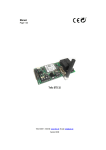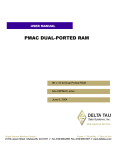Download ^1 USER MANUAL ^2 Accessory 20
Transcript
^1 USER MANUAL ^2 Accessory 20 ^3 Burr Brown Alphanumeric Entry & Display ^4 3Ax-CTM200-xUxx ^5 October 15, 2003 Single Source Machine Control Power // Flexibility // Ease of Use 21314 Lassen Street Chatsworth, CA 91311 // Tel. (818) 998-2095 Fax. (818) 998-7807 // www.deltatau.com Copyright Information © 2003 Delta Tau Data Systems, Inc. All rights reserved. This document is furnished for the customers of Delta Tau Data Systems, Inc. Other uses are unauthorized without written permission of Delta Tau Data Systems, Inc. Information contained in this manual may be updated from time-to-time due to product improvements, etc., and may not conform in every respect to former issues. To report errors or inconsistencies, call or email: Delta Tau Data Systems, Inc. Technical Support Phone: (818) 717-5656 Fax: (818) 998-7807 Email: [email protected] Website: http://www.deltatau.com Operating Conditions All Delta Tau Data Systems, Inc. motion controller products, accessories, and amplifiers contain static sensitive components that can be damaged by incorrect handling. When installing or handling Delta Tau Data Systems, Inc. products, avoid contact with highly insulated materials. Only qualified personnel should be allowed to handle this equipment. In the case of industrial applications, we expect our products to be protected from hazardous or conductive materials and/or environments that could cause harm to the controller by damaging components or causing electrical shorts. When our products are used in an industrial environment, install them into an industrial electrical cabinet or industrial PC to protect them from excessive or corrosive moisture, abnormal ambient temperatures, and conductive materials. If Delta Tau Data Systems, Inc. products are directly exposed to hazardous or conductive materials and/or environments, we cannot guarantee their operation. ^1 USER MANUAL Accessory 20 Table of Contents INTRODUCTION .......................................................................................................................................................1 ACC-20 CABLES ........................................................................................................................................................3 PMAC SETUP .............................................................................................................................................................5 TERMINAL SETUP ...................................................................................................................................................7 PROGRAMMING FUNCTION KEYS.....................................................................................................................9 USING ALPHANUMERIC KEYBOARD ..............................................................................................................11 An Example of Acc-20 Use within a PMAC Program............................................................................................11 Use of Function Keys..........................................................................................................................................11 Special Use of PMAC’s P0 Variable ..................................................................................................................11 GRAPHICS ................................................................................................................................................................13 Table of Contents i Accessory 20 ii Table of Contents Accessory 20 INTRODUCTION PMAC's Accessory 20 (ACC-20) is a small size serial communication terminal manufactured by Burr Brown (model # CTM200G). This model replaces the TM2500 terminal previously used. ACC-20 is typically used in applications where it is more convenient to use a small self-contained keyboard/display terminal (rather than a Host based computer) to communicate to the PMAC card via its serial connector. The unit may be used either as a hand-held terminal or it may be rack mounted. The terminal includes a large 16-character liquid crystal display. The sealed keyboard has 24 keys consisting of numerical keypad or optional alphanumeric keypad. By using the "SHIFT" key, the six function keys are mapped to give access to 18 functions. CTM200G runs on standard +5V power supply that is brought in through the supplied RS232 flat cable for PMAC-PC, PMAC-VME and the new PMAC-LITE. For the STD32 bus version of PMAC, a separate power supply is required. For physical dimensions and mounting information, refer to the enclosed diagram. Introduction 1 Accessory 20 2 Introduction Accessory 20 ACC-20 CABLES Depending of the specific version of PMAC there are three different RS232 connection cables available. These cables may be ordered as ACC-20 options. • • • ACC-20 Option 1 is the RS232 cable for the connection of ACC-20 with PMAC-PC and PMACVME. ACC-20 Option 2 is the RS232 cable for the connection of ACC-20 with PMAC - STD32. ACC-20 Option 3 is the RS232 cable for the connection of ACC-20 with PMAC-LITE. ACC-20 Cables 3 Accessory 20 4 ACC-20 Cables Accessory 20 PMAC SETUP To use the hand held terminal with PMAC, the following modifications need to be made: • • On PMAC-VME, PMAC-PC, and PMAC-LITE install jumper E8 to allow +5V supply from PMAC to drive the CMT200G. (This jumper is installed by default). Set I3 (I/O handshake Control I-variable) to zero. PMAC Setup 5 Accessory 20 6 PMAC Setup Accessory 20 TERMINAL SETUP Before the first time use of ACC-20 with PMAC, it should be setup correctly using the Setup procedure described in the CTM200G Manual. This Manual is supplied with the purchase of ACC-20. Chapter 3 of the Manual describes the setup procedure. The setup parameters should then be saved with the SAVE command (F8 or SHIFT F2). Once saved the terminal block may be connected to PMAC's serial communication connector. Note that ACC-20’s options 1 to 3 provide the appropriate connecting cable for the various versions of PMAC. Refer to the enclosed wiring diagrams. NOTE: To carry out the initial (one time) setup procedure, you need to communicate with ACC-20 directly through a serial host (other than PMAC). This may be a regular RS232 terminal or a PC based terminal emulator. Once the setup parameters are saved in the memory of ACC-20, it can be connected to PMAC. The following setup parameters should be chosen for operation with PMAC (refer to section 3.3 of the CTM200 Manual): Host Baud... Host Port Data... Host Port Stop Bit... Host Handshake... Keyboard enable... Keyboard repeat. Keyboard click... Keyboard Setup... Enter Key Control... Display Flashing... Display Cursor... Autowrap. Local Enable... Newline. Delay Rate... Terminal Setup User selectable to match PMAC's selected by jumpers E44 to E47. Should be set to "8 NONE". Should be set to "1" (Factory default). Should be set to "None" (Factory default). Should be set to "ON" (Factory default). Should be set to "ON" (Factory default). Should be set to "ON" (Factory default). Should be set according to the users needs. Should be set to CR/LF. Should be set to according to the users needs. Should be set to according to the users needs. Should be set to "OFF" (Factory Default) Should be set to "ON" (this is not Factory Default). Should be set to "OFF" (Factory Default) 0 ms (Factory Default). 7 Accessory 20 8 Terminal Setup Accessory 20 PROGRAMMING FUNCTION KEYS Refer to section 5.1 of the CTM200G manual for general host commands. In particular, the function keys may be programmed through the "m" command by issuing <ESC>m<function key number>TEXT <STX> (see page 5-17 of the CTM200G Manual). Each function key may be programmed to send various ASCII strings (or text) to PMAC (the maximum number of characters is limited to six). Example: To program F1 to send "J+" to PMAC you would have to have (previously) programmed the CTM200G by sending to its RS232 port the following sequence: <ESC>m01J+<STX> Here 01 refers to function key 1 (F1). Note: <STX> is usually mapped to the "Ctrl B" character code on most PC computers. All together, there are 18 function keys. Once programmed, the key definitions are automatically saved and need not be re-entered upon subsequent power up. To access F7 to F12, a Shift key should be pressed once before pressing keys F1 to F6 respectively. For F13 to F18, press the Shift key twice before pressing F1 to F6. Programming Function Keys 9 Accessory 20 10 Programming Function Keys Accessory 20 USING ALPHANUMERIC KEYBOARD Refer to section 9.1 of the CTM200G Manual for the description of the alphanumeric keys' access. The left letters are accessed by pressing the shift key once before pressing the corresponding key. The right letters are accessed by pressing the shift key twice. Example: To read the value of the M-variable 100 the following keys are pressed Shift7100 <Enter> An Example of Acc-20 Use within a PMAC Program Use of Function Keys In most applications of ACC-20, the functions keys are pre-programmed to correspond to the definition of the most commonly used PMAC on-line command strings. Example: To program the function key F2 to correspond to the PMAC command string "&1b2r" (meaning in coordinate system 1 begin at the top of program 2 and then run), the following commands need to be sent to the CTM200G from the PC prior to its connection to the PMAC card: <ESC>m02&1b2r<STX> Once this function (F2 is this case) has been programmed, every time it is pressed, the ASCII string for "&1b2r" is sent to PMAC. According to specific applications, the 18 function keys may be programmed to correspond to the most widely used command strings. Special Use of PMAC’s P0 Variable Of the 1024 P-variables of PMAC, P0 has a specific feature, which is very useful for use with the Accessory 20. This variable's content (stored internally as a 48-bit floating number) is automatically updated whenever a number is entered from the current PMAC Host Port followed by <CR> (carriage return). When the CTM200G acts as the PMAC host, then the value of P0 would correspond to the latest numerical entry from the terminal when followed by a <CR>. A typical utilization of this feature would be to enter commanded positions, feedrates, move times etc. into PLC or Motion programs. The following programming example demonstrates the use of P0 entries via the CTM200G's keyboard: Using Alphanumeric Keyboard 11 Accessory 20 This program demonstrates the use of the p-variable zero ;(p0) within a motion program. P0 is specifically designed to contain the latest numerical entry from the host. This feature allows the processing of numerical constants entered from the keyboard to PMAC’s buffered programs. In this particular example, P0 is used to enter the x and the y vectors entries in a motion program. Moreover, the vectors are restricted to be greater or equal to 0.001 units of length. The absolute value of this unit would have been previously defined using the PMAC’s axes definition statements. CLOSE OPEN PROG 1 INC ; RELATIVE MOVES F1000 ; SET FEEDRATE FOR STANDARD BLENDED MOVE N10 P0=0.0009 ; INITIALIZE P0 TO AN ILLEGAL VECTOR SIZE SENDS " ENTER THE NEXT VECTOR FOR X-AXIS " WHILE (P0<=0.001 OR P0>=-0.001) ; WAIT FOR KEYBOARD ENTRY DELAY 2000 SENDS " MAGNITUDE OF VECTOR MUST BE = OR > 0.001" SENDS " ENTER THE VECTOR AGAIN" END WHILE P1=P0 ; SAVE ENTRY FOR X-VECTOR P0=0.0009 ; INITIALIZE P0 AGAIN SENDS " ENTER THE NEXT VECTOR FOR Y-AXIS" WHILE (P0<=0.001 OR PO>=-0.001) ; WAIT FOR KEYBOARD ENTRY DELAY 2000 SENDS " MAGNITUDE OF VECTOR MUST BE = OR > 0.001" SENDS " ENTER THE VECTOR AGAIN" END WHILE P2=P0 ; SAVE THE ENTRY FOR Y-VECTOR X(P1) Y(P2) ; NOW MAKE THE MOVE GOTO 10 ; LOOP BACK FOR THE NEXT VECTOR CLOSE Note The use of P0 in the above program has saved the user from using several SHIFT keys followed by many character key entries. 12 Using Alphanumeric Keyboard Accessory 20 GRAPHICS Acc-20 Burr-Brown CTM200G Alphanumeric Entry and Display Unit 4.00 in.(101.6 mm) 7.00 in.(177.8 mm) Shift Delete 1 2 3 A B C D E F 4 5 6 G H I J K L 7 8 9 M N O P Q R Space S T - 0 U V W X Enter Y Z Front View .38in. (9.65mm) .75 in. (19.05mm) .38in. (9.65mm) .75 in. (19.05mm) Mounting Holes Main Port .75 in. (19.05mm) .75 in. (19.05mm) .38in. (9.65mm) 1.25 in. (31.75mm) Graphics .25 in. (6.35mm) Rear View .38in. (9.65mm) 13 Accessory 20 Burr-Brown CTM200G Terminal Connections with PMAC-PC, PMAC-VME +5V ACC-20 CTM200G TX BURR-BROWN RX TERMINAL (26-PIN HEADER) SIG GND 2 2 3 3 RD/ 5 5 SD/ 13 13 GND 7 RTS/ 9 CTS/ 8 CTS 10 +5V PMAC J4 (26-PIN HEADER) RTS Install E8 to allow +5V out from PMAC NOTE: Order ACC-20 Option 1 for this cable Burr-Brown CTM200G Terminal Connections with PMAC-LITE ACC-20 CTM200G BURR-BROWN TERMINAL (26-PIN HEADER) +5V TX RX GND 2 10 3 5 RXD/ 5 3 TXD/ 13 9 GND 4 CTS 6 RTS +5V PMAC-LITE J4 (10-PIN HEADER) NOTE: Order ACC-20 Option 3 for this cable 14 Graphics Accessory 20 Burr-Brown CTM200G Terminal Connections with PMAC-STD32 +5V SUPPLY GND 2 4 ACC-20 3 TX CTM200G BURR-BROWN RX 5 TERMINAL (26-PIN SIG GND 13 HEADER) GND 1 1 RXD/ 2 TXD/ 3 GND +5V CTS PMAC-STD32 J1 (5-PIN HEADER) NOTE: This connection requires an external power supply (+5V). This power supply may be brought out from PMAC's JMACH1 (J8) connector. Order ACC-20 Option 2 for this cable. Burr-Brown CTM200G Terminal Connections with an IBM-PC +5V SUPPLY +5V ACC-20 CTM200G BURR-BROWN TERMINAL (26-PIN HEADER) GND 2 3 3 5 2 GND 13 7 GND 1 TX RX RX IBM-PC RS232 TX CONNECTOR (DB25) SIG GND NOTE: This connection is necessary for the preprogramming of ACC-20 function keys and its initial setup for use with PMAC Graphics 15






























